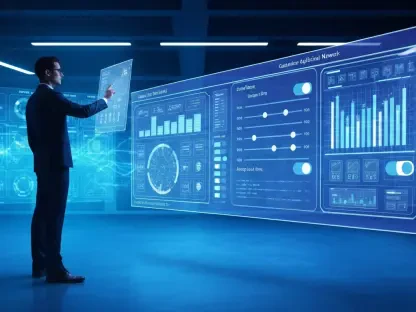In today’s rapidly evolving business environment, digital transformation is reshaping the landscape of supply chains, making the integration of technology a non-negotiable component of success. The reliance on traditional methods no longer suffices to meet the demands of globalized markets, characterized by volatile consumer preferences and complex logistical challenges. This scenario has positioned technologies like artificial intelligence (AI), cybersecurity, and real-time monitoring as indispensable tools in enhancing operational efficiency and reliability. These technologies not only provide a competitive edge but also cater to the increasing demand for precision, transparency, and agility within supply chains operating across diverse geographies and industries.
The Role of Artificial Intelligence in Supply Chain Management
Artificial intelligence has increasingly become the backbone of many advanced supply chain innovations, revolutionizing areas from demand forecasting to inventory management. With its ability to analyze vast datasets quickly, AI enables organizations to predict consumer demand with unprecedented accuracy. This precision in forecasting is achieved through machine learning models that adapt to input data, such as real-time sales figures, historical trends, and external variables like weather conditions. As a result, businesses can reduce overstock and understock situations, thereby optimizing inventory levels to meet consumer demand without unnecessary surpluses or shortages.
Additionally, AI plays a crucial role in optimizing fulfillment processes by analyzing transportation costs and demand patterns. Organizations leverage AI-driven insights to strategically position inventory, minimizing lead times and reducing the need for time-consuming cross-country shipments. Automated systems can dynamically allocate resources based on predictive analyses, ensuring that stocks are available at the right place and time, thus enhancing order accuracy and customer satisfaction. The adoption of AI in supply chains also extends to exception management, where machine learning models identify anomalies such as delivery delays and route deviations, enabling preemptive corrective measures. As AI continues to integrate deeply into supply chains, its potential to transform traditional logistics challenges into data-driven strategies becomes more evident.
Strengthening Cybersecurity in Supply Chains
As supply chains become more digitized, the importance of cybersecurity grows, with threats evolving from conceptual risks to significant operational concerns. The digital expansion in logistics has increased the number of access points for cyberattacks, underscoring the necessity for robust security measures. Events such as major cyber incidents affecting giants like Maersk have highlighted the potential disruptions that cybersecurity breaches can cause. Consequently, logistics organizations are moving towards implementing Zero Trust frameworks, which prioritize identity verification, strict access controls, and continuous monitoring of all network activities to protect sensitive information and infrastructure.
The security of APIs, which act as critical data exchange interfaces in modern logistics, is another focal point. Many supply chains still use outdated standards to manage APIs, presenting vulnerabilities that could be exploited by cybercriminals. Ensuring these interfaces are equipped with the latest security protocols is essential for safeguarding system integrity. Moreover, comprehensive cybersecurity strategies involve ongoing staff training to enhance awareness and adherence to security policies. By fostering a culture of cybersecurity diligence, companies can better protect their assets against data breaches, ensuring smoother operations and preserving consumer trust in the supply chain process.
Real-Time Monitoring for Enhanced Visibility and Control
Real-time monitoring technologies have become vital in creating transparent and responsive supply chains, bridging the gap between planned operations and on-the-ground realities. Utilizing sensors and telematics, organizations acquire real-time data on shipments, enabling precise tracking of high-value goods and optimizing fleet management. Technologies such as GPS tracking devices and cellular data feeds allow operators to monitor cargo locations continuously and respond swiftly to unforeseen events or deviations from planned routes, thus maintaining the integrity of supply chain promises to partners and customers.
In addition to tracking, environmental monitoring has gained significant traction, particularly in industries dealing with perishable goods or sensitive pharmaceuticals. Real-time sensors monitor environmental conditions such as temperature and humidity, ensuring compliance with regulatory standards and preventing product damage. This capability is especially critical in cold chain logistics, where even minor fluctuations in conditions can lead to substantial losses. Furthermore, telematics data offers insights for operational improvements, allowing fleet managers to enhance fuel efficiency and plan maintenance schedules strategically. While these benefits are evident, maximizing the advantages of real-time monitoring requires a structured data governance approach to filter actionable insights from the constant influx of data.
Emerging Trends and Integration Challenges
As supply chains continue to undergo digital transformation, several overarching trends have become apparent. One key trend is the demand for integration and interoperability across various technological systems. Effective integration of AI, cybersecurity, and real-time monitoring depends on the seamless connectivity of digital platforms, which, if not managed well, can result in disjointed operations and missed opportunities for improvement. Establishing standardization practices and ensuring comprehensive data governance can mitigate such challenges, allowing for smoother transitions and enhanced decision-making capabilities.
The transition to real-time operations is another significant trend, fueled by the need for immediate data-driven responses to dynamic market conditions. This shift aims to provide greater transparency and efficiency, necessitating advanced capabilities in data acquisition and processing. Moreover, cybersecurity has evolved into a cornerstone of digital supply chain strategy, given the rising dependency on digital platforms and the associated risks. The inclusion of cybersecurity considerations in operational planning is now as critical as traditional elements like inventory management and transport logistics. Addressing these integration challenges requires investment in technology and a commitment from senior leadership to embed these solutions into the organization’s culture and processes.
Achieving Strategic Success with Technology Integration
Strategic success in supply chains hinges on the effective integration of cutting-edge technologies into organizational processes and decision-making frameworks. While AI offers transformative potential in forecasting and execution, its effectiveness depends on the availability and accuracy of input data. Similarly, real-time monitoring provides critical situational awareness that, when aligned with robust execution systems, enables timely interventions to mitigate disruptions. Concurrently, cybersecurity maturity determines the extent to which organizations can shield themselves from external threats, ensuring uninterrupted supply chain operations.
However, without proper alignment and data governance, these technologies can introduce additional complexity rather than clear benefits. Persistent integration gaps between technological tools and core systems can limit the optimization potential of supply chain processes, emphasizing the importance of viewing data and digital solutions as foundational elements akin to physical infrastructure. Organizations that excel treat data as a strategic asset, applying the same diligence and consistency to its management as they do to other core business resources. By fostering a culture that values strategic alignment and continuous improvement, companies can harness the power of technology to achieve sustainable competitive advantages in the supply chain sector.
Navigating the Path Forward in Supply Chain Optimization
In today’s swiftly changing business world, digital transformation is fundamentally altering supply chains, making tech integration essential for success. The old ways don’t cut it anymore in global markets, characterized by unpredictable consumer choices and intricate logistical hurdles. Technologies like artificial intelligence (AI), cybersecurity, and real-time monitoring have become vital tools to boost operational efficiency and reliability. These advancements not only offer a competitive advantage but also address the growing need for precision, transparency, and flexibility in supply chains active across various sectors and regions. The digital shift isn’t just about keeping up; it’s about strategically positioning businesses to meet future challenges head-on. With AI, companies can predict trends and automate processes, while cybersecurity ensures the protection of sensitive data, and real-time monitoring allows instant tracking and adjustments. These elements are crucial in crafting supply chains that are resilient, responsive, and capable of thriving in the modern landscape.









